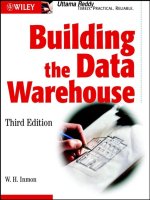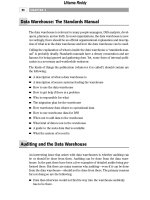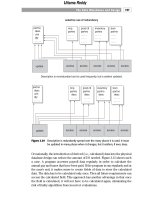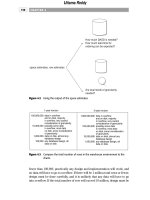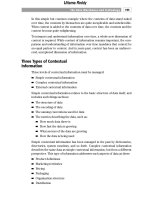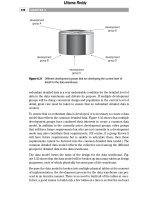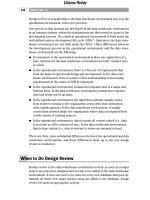Building the Data Warehouse Third Edition phần 1 ppt
Bạn đang xem bản rút gọn của tài liệu. Xem và tải ngay bản đầy đủ của tài liệu tại đây (617.87 KB, 43 trang )
TEAMFLY
Team-Fly
®
Uttama Reddy
John Wiley & Sons, Inc.
NEW YORK • CHICHESTER • WEINHEIM • BRISBANE • SINGAPORE • TORONTO
Wiley Computer Publishing
W. H. Inmon
Building the
Data Warehouse
Third Edition
Uttama Reddy
Uttama Reddy
Building the
Data Warehouse
Third Edition
Uttama Reddy
Uttama Reddy
John Wiley & Sons, Inc.
NEW YORK • CHICHESTER • WEINHEIM • BRISBANE • SINGAPORE • TORONTO
Wiley Computer Publishing
W. H. Inmon
Building the
Data Warehouse
Third Edition
Uttama Reddy
Publisher: Robert Ipsen
Editor: Robert Elliott
Developmental Editor: Emilie Herman
Managing Editor: John Atkins
Text Design & Composition: MacAllister Publishing Services, LLC
Designations used by companies to distinguish their products are often claimed as trademarks. In all
instances where John Wiley & Sons, Inc., is aware of a claim, the product names appear in initial cap-
ital or
ALL CAPITAL LETTERS. Readers, however, should contact the appropriate companies for more com-
plete information regarding trademarks and registration.
This book is printed on acid-free paper.
Copyright © 2002 by W.H. Inmon. All rights reserved.
Published by John Wiley & Sons, Inc.
Published simultaneously in Canada.
No part of this publication may be reproduced, stored in a retrieval system or transmitted in any form
or by any means, electronic, mechanical, photocopying, recording, scanning or otherwise, except as
permitted under Sections 107 or 108 of the 1976 United States Copyright Act, without either the prior
written permission of the Publisher, or authorization through payment of the appropriate per-copy fee
to the Copyright Clearance Center, 222 Rosewood Drive, Danvers, MA 01923, (978) 750-8400, fax (978)
750-4744. Requests to the Publisher for permission should be addressed to the Permissions Depart-
ment, John Wiley & Sons, Inc., 605 Third Avenue, New York, NY 10158-0012, (212) 850-6011, fax (212)
850-6008, E-Mail: PERMREQ @ WILEY.COM.
This publication is designed to provide accurate and authoritative information in regard to the subject
matter covered. It is sold with the understanding that the publisher is not engaged in professional ser-
vices. If professional advice or other expert assistance is required, the services of a competent pro-
fessional person should be sought.
Library of Congress Cataloging-in-Publication Data:
ISBN: 0-471-08130-2
Printed in the United States of America.
10 9 8 7 6 5 4 3 2 1
Uttama Reddy
To Jeanne Friedman—a friend for all times
Uttama Reddy
Uttama Reddy
CONTENTS
Preface for the Second Edition xiii
Preface for the Third Edition xiv
Acknowledgments xix
About the Author xx
Chapter 1 Evolution of Decision Support Systems 1
The Evolution 2
The Advent of DASD 4
PC/4GL Technology 4
Enter the Extract Program 5
The Spider Web 6
Problems with the Naturally Evolving Architecture 6
Lack of Data Credibility 6
Problems with Productivity 9
From Data to Information 12
A Change in Approach 15
The Architected Environment 16
Data Integration in the Architected Environment 19
Who Is the User? 19
The Development Life Cycle 21
Patterns of Hardware Utilization 22
Setting the Stage for Reengineering 23
Monitoring the Data Warehouse Environment 25
Summary 28
Chapter 2 The Data Warehouse Environment 31
The Structure of the Data Warehouse 35
Subject Orientation 36
Day 1-Day n Phenomenon 41
Granularity 43
The Benefits of Granularity 45
An Example of Granularity 46
Dual Levels of Granularity 49
vii
Uttama Reddy
Exploration and Data Mining 53
Living Sample Database 53
Partitioning as a Design Approach 55
Partitioning of Data 56
Structuring Data in the Data Warehouse 59
Data Warehouse: The Standards Manual 64
Auditing and the Data Warehouse 64
Cost Justification 65
Justifying Your Data Warehouse 66
Data Homogeneity/Heterogeneity 69
Purging Warehouse Data 72
Reporting and the Architected Environment 73
The Operational Window of Opportunity 74
Incorrect Data in the Data Warehouse 76
Summary 77
Chapter 3 The Data Warehouse and Design 81
Beginning with Operational Data 82
Data/Process Models and the Architected Environment 87
The Data Warehouse and Data Models 89
The Data Warehouse Data Model 92
The Midlevel Data Model 94
The Physical Data Model 98
The Data Model and Iterative Development 102
Normalization/Denormalization 102
Snapshots in the Data Warehouse 110
Meta Data 113
Managing Reference Tables in a Data Warehouse 113
Cyclicity of Data-The Wrinkle of Time 115
Complexity of Transformation and Integration 118
Triggering the Data Warehouse Record 122
Events 122
Components of the Snapshot 123
Some Examples 123
Profile Records 124
Managing Volume 126
Creating Multiple Profile Records 127
CONTENTS
viii
TEAMFLY
Team-Fly
®
Uttama Reddy
Going from the Data Warehouse to the Operational
Environment 128
Direct Access of Data Warehouse Data 129
Indirect Access of Data Warehouse Data 130
An Airline Commission Calculation System 130
A Retail Personalization System 132
Credit Scoring 133
Indirect Use of Data Warehouse Data 136
Star Joins 137
Supporting the ODS 143
Summary 145
Chapter 4 Granularity in the Data Warehouse 147
Raw Estimates 148
Input to the Planning Process 149
Data in Overflow? 149
Overflow Storage 151
What the Levels of Granularity Will Be 155
Some Feedback Loop Techniques 156
Levels of Granularity-Banking Environment 158
Summary 165
Chapter 5 The Data Warehouse and Technology 167
Managing Large Amounts of Data 167
Managing Multiple Media 169
Index/Monitor Data 169
Interfaces to Many Technologies 170
Programmer/Designer Control of Data Placement 171
Parallel Storage/Management of Data 171
Meta Data Management 171
Language Interface 173
Efficient Loading of Data 173
Efficient Index Utilization 175
Compaction of Data 175
Compound Keys 176
Variable-Length Data 176
Lock Management 176
CONTENTS
ix
Uttama Reddy
Index-Only Processing 178
Fast Restore 178
Other Technological Features 178
DBMS Types and the Data Warehouse 179
Changing DBMS Technology 181
Multidimensional DBMS and the Data Warehouse 182
Data Warehousing across Multiple Storage Media 188
Meta Data in the Data Warehouse Environment 189
Context and Content 192
Three Types of Contextual Information 193
Capturing and Managing Contextual Information 194
Looking at the Past 195
Refreshing the Data Warehouse 195
Testing 198
Summary 198
Chapter 6 The Distributed Data Warehouse 201
Types of Distributed Data Warehouses 202
Local and Global Data Warehouses 202
The Technologically Distributed Data Warehouse 220
The Independently Evolving Distributed Data Warehouse 221
The Nature of the Development Efforts 222
Completely Unrelated Warehouses 224
Distributed Data Warehouse Development 226
Coordinating Development across Distributed Locations 227
The Corporate Data Model-Distributed 228
Meta Data in the Distributed Warehouse 232
Building the Warehouse on Multiple Levels 232
Multiple Groups Building the Current Level of Detail 235
Different Requirements at Different Levels 238
Other Types of Detailed Data 239
Meta Data 244
Multiple Platforms for Common Detail Data 244
Summary 245
Chapter 7 Executive Information Systems and the Data Warehouse 247
EIS-The Promise 248
A Simple Example 248
Drill-Down Analysis 251
CONTENTS
x
Uttama Reddy
Supporting the Drill-Down Process 253
The Data Warehouse as a Basis for EIS 254
Where to Turn 256
Event Mapping 258
Detailed Data and EIS 261
Keeping Only Summary Data in the EIS 262
Summary 263
Chapter 8 External/Unstructured Data and the Data Warehouse 265
External/Unstructured Data in the Data Warehouse 268
Meta Data and External Data 269
Storing External/Unstructured Data 271
Different Components of External/Unstructured Data 272
Modeling and External/Unstructured Data 273
Secondary Reports 274
Archiving External Data 275
Comparing Internal Data to External Data 275
Summary 276
Chapter 9 Migration to the Architected Environment 277
A Migration Plan 278
The Feedback Loop 286
Strategic Considerations 287
Methodology and Migration 289
A Data-Driven Development Methodology 291
Data-Driven Methodology 293
System Development Life Cycles 294
A Philosophical Observation 294
Operational Development/DSS Development 294
Summary 295
Chapter 10 The Data Warehouse and the Web 297
Supporting the Ebusiness Environment 307
Moving Data from the Web to the Data Warehouse 307
Moving Data from the Data Warehouse to the Web 308
Web Support 309
Summary 310
CONTENTS
xi
Uttama Reddy
Chapter 11 ERP and the Data Warehouse 311
ERP Applications Outside the Data Warehouse 312
Building the Data Warehouse inside the ERP Environment 314
Feeding the Data Warehouse through ERP and Non-ERP
Systems 314
The ERP-Oriented Corporate Data Warehouse 318
Summary 320
Chapter 12 Data Warehouse Design Review Checklist 321
When to Do Design Review 322
Who Should Be in the Design Review? 323
What Should the Agenda Be? 323
The Results 323
Administering the Review 324
A Typical Data Warehouse Design Review 324
Summary 342
Appendix 343
Glossary 385
Reference 397
Index 407
CONTENTS
XII
Uttama Reddy
Introduction
xiii
Databases and database theory have been around for a long time. Early rendi-
tions of databases centered around a single database serving every purpose
known to the information processing community—from transaction to batch
processing to analytical processing. In most cases, the primary focus of the
early database systems was operational—usually transactional—processing. In
recent years, a more sophisticated notion of the database has emerged—one
that serves operational needs and another that serves informational or analyti-
cal needs. To some extent, this more enlightened notion of the database is due
to the advent of PCs, 4GL technology, and the empowerment of the end user.
The split of operational and informational databases occurs for many reasons:
■■
The data serving operational needs is physically different data from that
serving informational or analytic needs.
■■
The supporting technology for operational processing is fundamentally dif-
ferent from the technology used to support informational or analytical
needs.
■■
The user community for operational data is different from the one served
by informational or analytical data.
■■
The processing characteristics for the operational environment and the
informational environment are fundamentally different.
Because of these reasons (and many more), the modern way to build systems is
to separate the operational from the informational or analytical processing and
data.
This book is about the analytical [or the decision support systems (DSS)] envi-
ronment and the structuring of data in that environment. The focus of the book
is on what is termed the “data warehouse” (or “information warehouse”), which
is at the heart of informational, DSS processing.
The discussions in this book are geared to the manager and the developer.
Where appropriate, some level of discussion will be at the technical level. But,
for the most part, the book is about issues and techniques. This book is meant
to serve as a guideline for the designer and the developer.
PREFACE FOR THE SECOND EDITION
xiii
Uttama Reddy
When the first edition of Building the Data Warehouse was printed, the data-
base theorists scoffed at the notion of the data warehouse. One theoretician
stated that data warehousing set back the information technology industry 20
years. Another stated that the founder of data warehousing should not be
allowed to speak in public. And yet another academic proclaimed that data
warehousing was nothing new and that the world of academia had known
about data warehousing all along although there were no books, no articles, no
classes, no seminars, no conferences, no presentations, no references, no
papers, and no use of the terms or concepts in existence in academia at that
time.
When the second edition of the book appeared, the world was mad for anything
of the Internet. In order to be successful it had to be “e” something—e-business,
e-commerce, e-tailing, and so forth. One venture capitalist was known to say,
“Why do we need a data warehouse when we have the Internet?”
But data warehousing has surpassed the database theoreticians who wanted to
put all data in a single database. Data warehousing survived the dot.com disas-
ter brought on by the short-sighted venture capitalists. In an age when technol-
ogy in general is spurned by Wall Street and Main Street, data warehousing has
never been more alive or stronger. There are conferences, seminars, books,
articles, consulting, and the like. But mostly there are companies doing data
warehousing, and making the discovery that, unlike the overhyped New Econ-
omy, the data warehouse actually delivers, even though Silicon Valley is still in
a state of denial.
The third edition of this book heralds a newer and even stronger day for data
warehousing. Today data warehousing is not a theory but a fact of life. New
technology is right around the corner to support some of the more exotic needs
of a data warehouse. Corporations are running major pieces of their business
on data warehouses. The cost of information has dropped dramatically because
of data warehouses. Managers at long last have a viable solution to the ugliness
of the legacy systems environment. For the first time, a corporate “memory” of
historical information is available. Integration of data across the corporation is
a real possibility, in most cases for the first time. Corporations are learning how
PREFACE FOR THE THIRD EDITION
xiv
Uttama Reddy
to go from data to information to competitive advantage. In short, data ware-
housing has unlocked a world of possibility.
One confusing aspect of data warehousing is that it is an architecture, not a
technology. This frustrates the technician and the venture capitalist alike
because these people want to buy something in a nice clean box. But data ware-
housing simply does not lend itself to being “boxed up.” The difference between
an architecture and a technology is like the difference between Santa Fe, New
Mexico, and adobe bricks. If you drive the streets of Santa Fe you know you are
there and nowhere else. Each home, each office building, each restaurant has a
distinctive look that says “This is Santa Fe.” The look and style that make Santa
Fe distinctive are the architecture. Now, that architecture is made up of such
things as adobe bricks and exposed beams. There is a whole art to the making
of adobe bricks and exposed beams. And it is certainly true that you could not
have Santa Fe architecture without having adobe bricks and exposed beams.
But adobe bricks and exposed beams by themselves do not make an architec-
ture. They are independent technologies. For example, you have adobe bricks
throughout the Southwest and the rest of the world that are not Santa Fe
architecture.
Thus it is with architecture and technology, and with data warehousing and
databases and other technology. There is the architecture, then there is the
underlying technology, and they are two very different things. Unquestionably,
there is a relationship between data warehousing and database technology, but
they are most certainly not the same. Data warehousing requires the support of
many different kinds of technology.
With the third edition of this book, we now know what works and what does
not. When the first edition was written, there was some experience with devel-
oping and using warehouses, but truthfully, there was not the broad base of
experience that exists today. For example, today we know with certainty the
following:
■■
Data warehouses are built under a different development methodology
than applications. Not keeping this in mind is a recipe for disaster.
■■
Data warehouses are fundamentally different from data marts. The two do
not mix—they are like oil and water.
■■
Data warehouses deliver on their promise, unlike many overhyped tech-
nologies that simply faded away.
■■
Data warehouses attract huge amounts of data, to the point that entirely
new approaches to the management of large amounts of data are required.
But perhaps the most intriguing thing that has been learned about data ware-
housing is that data warehouses form a foundation for many other forms of
Preface for the Third Edition
xv
Uttama Reddy
processing. The granular data found in the data warehouse can be reshaped and
reused. If there is any immutable and profound truth about data warehouses, it
is that data warehouses provide an ideal foundation for many other forms of
information processing. There are a whole host of reasons why this foundation
is so important:
■■
There is a single version of the truth.
■■
Data can be reconciled if necessary.
■■
Data is immediately available for new, unknown uses.
And, finally, data warehousing has lowered the cost of information in the orga-
nization. With data warehousing, data is inexpensive to get to and fast to
access.
Databases and database theory have been around for a long time. Early rendi-
tions of databases centered around a single database serving every purpose
known to the information processing community—from transaction to batch
processing to analytical processing. In most cases, the primary focus of the
early database systems was operational—usually transactional—processing. In
recent years, a more sophisticated notion of the database has emerged—one
that serves operational needs and another that serves informational or analyti-
cal needs. To some extent, this more enlightened notion of the database is due
to the advent of PCs, 4GL technology, and the empowerment of the end user.
The split of operational and informational databases occurs for many reasons:
■■
The data serving operational needs is physically different data from that
serving informational or analytic needs.
■■
The supporting technology for operational processing is fundamentally dif-
ferent from the technology used to support informational or analytical
needs.
■■
The user community for operational data is different from the one served
by informational or analytical data.
■■
The processing characteristics for the operational environment and the
informational environment are fundamentally different.
For these reasons (and many more), the modern way to build systems is to sep-
arate the operational from the informational or analytical processing and data.
This book is about the analytical or the DSS environment and the structuring of
data in that environment. The focus of the book is on what is termed the data
warehouse (or information warehouse), which is at the heart of informational,
DSS processing.
What is analytical, informational processing? It is processing that serves the
needs of management in the decision-making process. Often known as DSS pro-
Preface for the Third Edition
xvi
Uttama Reddy
Preface for the Third Edition
xvii
cessing, analytical processing looks across broad vistas of data to detect
trends. Instead of looking at one or two records of data (as is the case in oper-
ational processing), when the DSS analyst does analytical processing, many
records are accessed.
It is rare for the DSS analyst to update data. In operational systems, data is con-
stantly being updated at the individual record level. In analytical processing,
records are constantly being accessed, and their contents are gathered for
analysis, but little or no alteration of individual records occurs.
In analytical processing, the response time requirements are greatly relaxed
compared to those of traditional operational processing. Analytical response
time is measured from 30 minutes to 24 hours. Response times measured in this
range for operational processing would be an unmitigated disaster.
The network that serves the analytical community is much smaller than the one
that serves the operational community. Usually there are far fewer users of the
analytical network than of the operational network.
Unlike the technology that serves the analytical environment, operational envi-
ronment technology must concern itself with data and transaction locking, con-
tention for data, deadlock, and so on.
There are, then, many major differences between the operational environment
and the analytical environment. This book is about the analytical, DSS environ-
ment and addresses the following issues:
■■
Granularity of data
■■
Partitioning of data
■■
Meta data
■■
Lack of credibility of data
■■
Integration of DSS data
■■
The time basis of DSS data
■■
Identifying the source of DSS data-the system of record
■■
Migration and methodology
This book is for developers, managers, designers, data administrators, database
administrators, and others who are building systems in a modern data process-
ing environment. In addition, students of information processing will find this
book useful. Where appropriate, some discussions will be more technical. But,
for the most part, the book is about issues and techniques, and it is meant to
serve as a guideline for the designer and the developer.
Uttama Reddy
This book is the first in a series of books relating to data warehouse. The next
book in the series is Using the Data Warehouse (Wiley, 1994). Using the Data
Warehouse addresses the issues that arise once you have built the data ware-
house. In addition, Using the Data Warehouse introduces the concept of a
larger architecture and the notion of an operational data store (ODS). An oper-
ational data store is a similar architectural construct to the data warehouse,
except the ODS applies only to operational systems, not informational systems.
The third book in the series is Building the Operational Data Store (Wiley,
1999), which addresses the issues of what an ODS is and how an ODS is built.
The next book in the series is Corporate Information Factory, Third Edition
(Wiley, 2002). This book addresses the larger framework of which the data
warehouse is the center. In many regards the CIF book and the DW book are
companions. The CIF book provides the larger picture and the DW book
provides a more focused discussion. Another related book is Exploration
Warehousing (Wiley, 2000). This book addresses a specialized kind of process-
ing-pattern analysis using statistical techniques on data found in the data
warehouse.
Building the Data Warehouse, however, is the cornerstone of all the related
books. The data warehouse forms the foundation of all other forms of DSS
processing.
There is perhaps no more eloquent testimony to the advances made by data
warehousing and the corporate information factory than the References at the
back of this book. When the first edition was published, there were no other
books, no white papers, and only a handful of articles that could be referenced.
In this third edition, there are many books, articles, and white papers that are
mentioned. Indeed the references only start to explore some of the more impor-
tant works.
Preface for the Third Edition
xviii
TEAMFLY
Team-Fly
®
Uttama Reddy
Introduction
xix
The following people have influenced—directly and indirectly—the material
found in this book. The author is grateful for the long-term relationships that
have been formed and for the experiences that have provided a basis for
learning.
Claudia Imhoff, Intelligent Solutions
Jon Geiger, Intelligent Solutions
Joyce Norris Montanari, Intelligent Solutions
John Zachman, Zachman International
John Ladley, Meta Group
Bob Terdeman, EMC Corporation
Dan Meers, BillInmon.com
Cheryl Estep, independent consultant
Lowell Fryman, independent consultant
David Fender, SAS Japan
Jim Davis, SAS
Peter Grendel, SAP
Allen Houpt, CA
ACKNOWLEDGMENTS
xix
Uttama Reddy
Bill Inmon, the father of the data warehouse concept, has written 40 books on
data management, data warehouse, design review, and management of data
processing. Bill has had his books translated into Russian, German, French,
Japanese, Portuguese, Chinese, Korean, and Dutch. Bill has published more
than 250 articles in many trade journals. Bill founded and took public Prism
Solutions. His latest company—Pine Cone Systems—builds software for the
management of the data warehouse/data mart environment. Bill holds two soft-
ware patents. Articles, white papers, presentations, and much more material
can be found on his Web site, www.billinmon.com.
ABOUT THE AUTHOR
xx
Uttama Reddy
Evolution of Decision
Support Systems
CHAPTER
1
W
e are told that the hieroglyphics in Egypt are primarily the work of an accoun-
tant declaring how much grain is owed the Pharaoh. Some of the streets in
Rome were laid out by civil engineers more than 2,000 years ago. Examina-
tion of bones found in archeological excavations shows that medicine—in, at
least, a rudimentary form—was practiced as long as 10,000 years ago. Other
professions have roots that can be traced back to antiquity. From this per-
spective, the profession and practice of information systems and processing
is certainly immature, because it has existed only since the early 1960s.
Information processing shows this immaturity in many ways, such as its ten-
dency to dwell on detail. There is the notion that if we get the details right, the
end result will somehow take care of itself and we will achieve success. It’s
like saying that if we know how to lay concrete, how to drill, and how to
install nuts and bolts, we don’t have to worry about the shape or the use of the
bridge we are building. Such an attitude would drive a more professionally
mature civil engineer crazy. Getting all the details right does not necessarily
bring more success.
The data warehouse requires an architecture that begins by looking at the
whole and then works down to the particulars. Certainly, details are impor-
tant throughout the data warehouse. But details are important only when
viewed in a broader context.
1
Uttama Reddy
The story of the data warehouse begins with the evolution of information and
decision support systems. This broad view should help put data warehousing
into clearer perspective.
The Evolution
The origins of DSS processing hark back to the very early days of computers
and information systems. It is interesting that decision support system (DSS)
processing developed out of a long and complex evolution of information tech-
nology. Its evolution continues today.
Figure 1.1 shows the evolution of information processing from the early 1960s
up to 1980. In the early 1960s, the world of computation consisted of creating
individual applications that were run using master files. The applications fea-
tured reports and programs, usually built in COBOL. Punched cards were com-
mon. The master files were housed on magnetic tape, which were good for
storing a large volume of data cheaply, but the drawback was that they had to
be accessed sequentially. In a given pass of a magnetic tape file, where 100 per-
cent of the records have to be accessed, typically only 5 percent or fewer of the
records are actually needed. In addition, accessing an entire tape file may take
as long as 20 to 30 minutes, depending on the data on the file and the process-
ing that is done.
Around the mid-1960s, the growth of master files and magnetic tape exploded.
And with that growth came huge amounts of redundant data. The proliferation
of master files and redundant data presented some very insidious problems:
■■
The need to synchronize data upon update
■■
The complexity of maintaining programs
■■
The complexity of developing new programs
■■
The need for extensive amounts of hardware to support all the master files
In short order, the problems of master files—problems inherent to the medium
itself—became stifling.
It is interesting to speculate what the world of information processing would
look like if the only medium for storing data had been the magnetic tape. If
there had never been anything to store bulk data on other than magnetic tape
CHAPTER 1
2
Uttama Reddy

